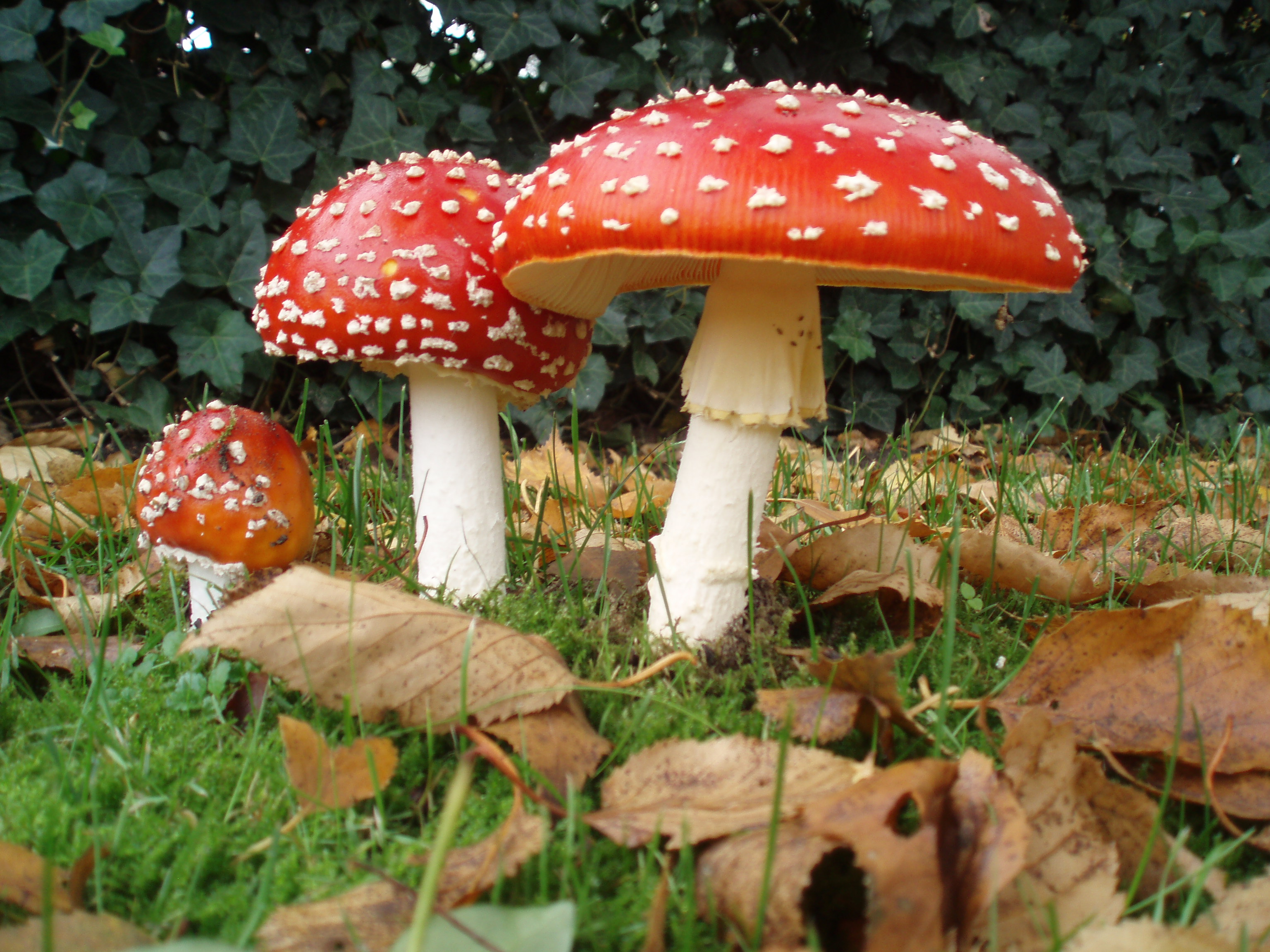Archaeological evidence of psychedelics:
Strange as it is, it is the human nervous system that generates consciousness and subconsciousness. ASC can
 be
brought about by many factors including; pain, sensory deprivation,
ingestion of psychotropic drugs etc. Hence, it is now thought, that some
of the many geometric patterns that decorate cave walls are the
drawings channelled by the nervous system after the ingestion of
psychedelics, the pictures themselves being perceived differently by
different cultures (Lewis-Williams & Clottes 1998). Such like the African rock art that Max Knoll discovered to show remarkable similarities to the imagery of altered states (Blundell 1998: 4).
Other universal images scribed while on psychedelics are thought to be;
the transformation of the self into animals; such as the half bison -
half human drawing in the Chauvet cave, as well as hallucinations being
projected onto surfaces (Lewis-Williams & Clottes 1998).
Since REM dreaming and ASC result in short term memory loss, due to
dropping levels of norepinephrine [Also known as Noradrenaline secreted
by the Adrenal Medulla for the reaction of fight or flight] and
serotonin [A chemical required for the storage of recent memories], it
is thought that rock art like the rock art in California, was made to
record the sacred before it was forgotten (Whitley 1998: 31-32).
Primarily female mushroom humans have been found carved in Chukchi
country that have been dated back to the Bronze Age, and it is known
that the use of Amanita muscaria was practiced by certain groups across Eurasia, while the Saami continued to use fly agaric well into the twentieth century (Devereux 1997:69),
hence psychedelic rock art is not so farfetched. Stone carvings have
also been found in Guatemala, Tabasco and Veracruz in Mexico which are
dated between 1000 and 300 B.C., some depicting a transformation of
human to animal, with mushrooms stemming upright from the head below (Wasson 1972: 188-189), the same animal transformation theme found in both stone sculptures and cave art.
The original homeland of Cannabis is thought to be central Asia, that
spread quickly to Africa and then other places, its adaptive properties (McKenna 1992: 150) and multiple uses (including; fibre, oil, nutrition, hallucinogenic properties and its ability to treat a wide range of ills, Hofmann & Schultes 1979)
made it a desirable plant to human beings. ‘The thousands of names by
which cannabis is known in hundreds of languages is testament...to its
cultural history...ubiquity... [and] its power to move language-making
faculty...’(McKenna 1992: 150). The widespread use of cannabis is
found via archaeological sites; in Non Nak Tha (Thailand), 15,000 B.P.
graves having been found with plant material repeatedly burned in the
hollow centre of animal bones (McKenna 1992: 151); 3000 B.C.
hempen rope and thread have been found in Turkestan; while ‘Stone
beaters for pounding hemp fibre and impressions of hempen cord baked
into pottery have been found in ancient sites in Taiwan’; as well as
possible specimens of hemp in an Egyptian tomb dated around three to
four thousand years ago. The use of cannabis as a psychedelic have been
found in Scythian tombs in Central Asia. Tripods, pelts, braziers and
charcoal with remains of cannabis leaves and fruit dated between 500 and
300 B.C. were obtained, and it’s believed that the Scythians spread
cannabis westward to Europe (Hofmann & Schultes 1979).
be
brought about by many factors including; pain, sensory deprivation,
ingestion of psychotropic drugs etc. Hence, it is now thought, that some
of the many geometric patterns that decorate cave walls are the
drawings channelled by the nervous system after the ingestion of
psychedelics, the pictures themselves being perceived differently by
different cultures (Lewis-Williams & Clottes 1998). Such like the African rock art that Max Knoll discovered to show remarkable similarities to the imagery of altered states (Blundell 1998: 4).
Other universal images scribed while on psychedelics are thought to be;
the transformation of the self into animals; such as the half bison -
half human drawing in the Chauvet cave, as well as hallucinations being
projected onto surfaces (Lewis-Williams & Clottes 1998).
Since REM dreaming and ASC result in short term memory loss, due to
dropping levels of norepinephrine [Also known as Noradrenaline secreted
by the Adrenal Medulla for the reaction of fight or flight] and
serotonin [A chemical required for the storage of recent memories], it
is thought that rock art like the rock art in California, was made to
record the sacred before it was forgotten (Whitley 1998: 31-32).
Primarily female mushroom humans have been found carved in Chukchi
country that have been dated back to the Bronze Age, and it is known
that the use of Amanita muscaria was practiced by certain groups across Eurasia, while the Saami continued to use fly agaric well into the twentieth century (Devereux 1997:69),
hence psychedelic rock art is not so farfetched. Stone carvings have
also been found in Guatemala, Tabasco and Veracruz in Mexico which are
dated between 1000 and 300 B.C., some depicting a transformation of
human to animal, with mushrooms stemming upright from the head below (Wasson 1972: 188-189), the same animal transformation theme found in both stone sculptures and cave art.
The original homeland of Cannabis is thought to be central Asia, that
spread quickly to Africa and then other places, its adaptive properties (McKenna 1992: 150) and multiple uses (including; fibre, oil, nutrition, hallucinogenic properties and its ability to treat a wide range of ills, Hofmann & Schultes 1979)
made it a desirable plant to human beings. ‘The thousands of names by
which cannabis is known in hundreds of languages is testament...to its
cultural history...ubiquity... [and] its power to move language-making
faculty...’(McKenna 1992: 150). The widespread use of cannabis is
found via archaeological sites; in Non Nak Tha (Thailand), 15,000 B.P.
graves having been found with plant material repeatedly burned in the
hollow centre of animal bones (McKenna 1992: 151); 3000 B.C.
hempen rope and thread have been found in Turkestan; while ‘Stone
beaters for pounding hemp fibre and impressions of hempen cord baked
into pottery have been found in ancient sites in Taiwan’; as well as
possible specimens of hemp in an Egyptian tomb dated around three to
four thousand years ago. The use of cannabis as a psychedelic have been
found in Scythian tombs in Central Asia. Tripods, pelts, braziers and
charcoal with remains of cannabis leaves and fruit dated between 500 and
300 B.C. were obtained, and it’s believed that the Scythians spread
cannabis westward to Europe (Hofmann & Schultes 1979). Although archaeological evidence doesn’t give us the whole picture, the use of psychedelics is not a recent occurrence and it is not only Homo sapiens that take narcotic substances. A widely known example is the cat and catnip. Catnip affects most felines due to nepetalactone, the active chemical which causes the cat to roll around and play, and is said to be similar to the affect of LSD or marijuana in humans (Cat World 2011), whereas black lemurs have been seen to anoint their bodies with bitten millipedes, salivating profusely. Some believe that the lemurs do this to induce a psychotropic state, whereas others such as Birkinshaw (1999) believe that it is unlikely, since after 3-4 minutes, the lemurs continue with their daily routine, with a disposition unchanged. However, the effect of catnip on felines is very quick, as well as some Salvia divinorum trips, lasting about 5 minutes in humans. McKenna (1992) believes that psychedelics may have catalysed the mental functions that we associate with being human such as language, and possibly art, which was explored in the 1950s by Dr. Oscar Janiger with LSD, finding that it opened up the unexplored areas of the mind (Lee & Shlain 1985: 61-62). We can therefore see that psychedelics may have been with us since the near beginning of our species.
Although archaeological evidence doesn’t give us the whole picture, the use of psychedelics is not a recent occurrence and it is not only Homo sapiens that take narcotic substances. A widely known example is the cat and catnip. Catnip affects most felines due to nepetalactone, the active chemical which causes the cat to roll around and play, and is said to be similar to the affect of LSD or marijuana in humans (Cat World 2011), whereas black lemurs have been seen to anoint their bodies with bitten millipedes, salivating profusely. Some believe that the lemurs do this to induce a psychotropic state, whereas others such as Birkinshaw (1999) believe that it is unlikely, since after 3-4 minutes, the lemurs continue with their daily routine, with a disposition unchanged. However, the effect of catnip on felines is very quick, as well as some Salvia divinorum trips, lasting about 5 minutes in humans. McKenna (1992) believes that psychedelics may have catalysed the mental functions that we associate with being human such as language, and possibly art, which was explored in the 1950s by Dr. Oscar Janiger with LSD, finding that it opened up the unexplored areas of the mind (Lee & Shlain 1985: 61-62). We can therefore see that psychedelics may have been with us since the near beginning of our species.Myth, Story and Religion:
Since psychedelics have been around for generations, it is therefore not absurd to think that certain stories, myths and religions may have been created through the visionary experiences that psychedelics perpetuate on the human mind. While the Father Christmas myth of his red garment, reindeer (who are known to search out and eat fly agaric) and Chimney escapades, mimic a Siberian yurt smoke hole in winter (Devereux 1997: 72) are contested with ideas of the Coca Cola company globalising the now renowned ‘fat-man’ to up sales (The coca-cola company 2011), other debates on the origins of Christianity and what is soma have raised far more heckles and theories.
Allegro (1970), Wasson (1972) and Teeter (2005) all believe the answer is Amanita muscaria. Allegro (1970) researched Semitic languages to tie in myths with the mushroom, such as the Hebrew word for mushroom: ‘Kotereth’, mentioned many times in the Bible. Allegro argues that the distinctive colouring, like that of the red blood of the woman meeting the white sperm of the man to make a child, meant that stories were woven around the mushroom. He also notes that there is evidence suggesting that Amanita muscaria became Soma. Wasson (1972) also believed that Soma, a deified plant mentioned in 120 of the 1028 hymns of the Rig-Veda [The Rig-Veda are hymns of the religion of the Aryans, they invaded northwest India in
approximately 1600 B.C. One of their divinities was the plant Soma (Wasson
1972: 201)] , was Amanita muscaria. He backs up his argument by saying that the Rig-Veda mentions nothing about roots, leaves, blossoms, fruit or seed, leaving the mushroom kingdom as the only option, and Amanita muscaria, because of the link to the Rig-Veda and Eurasian folklore. For example; when you drink Soma, you are said to urinate Soma. Wasson claims that this is a large clue that Soma is the fly agaric, since drinking the urine of those who have ingested fly agaric are known to gain greater effects. This occurred by the tribesmen of Chukotka and Kamchatka in the northeast of Siberia, as well as the Parsis, who still today consume urine in religious devotions, although now only bull’s urine as symbolism. Finally, Wasson proclaims that the use of Soma in Siberia has survived there only until recently, their culture saturated with intimacy of reindeer and the birch - the tree of the Shaman (the birch being the preferred host of the fly agaric), the pine tree being second to the birch for Siberian tribesmen, conifers being a place where fly agaric is also known to grow. However, objections have been made to this theory. One theory is that Soma is the psychoactive Peganum harmala [Syrian rue] due to its abundance in the Indo-Iranian region, whereas fly agaric was limited to a few mountain regions, a place where the valley residing Indo-Europeans would find hard to access (Devereux 1997: 75). Another theory, is that Soma is Stropharia cubensis (a dung loving mushroom) because of the reference to  cattle and pastoralism continually repeated in the Rig-Veda e.g. Soma mixed with milk, referred to as a ‘bull’, ergo, the drinking of bull urine in the Parsis religion. However, it is believed that as climatic conditions changed and Indo-Europeans migrated farther east, mild temperatures and grassland conditions for Stropharia cubensis ceased to be available, and Amanita muscaria was taken up as the replacement Soma. One reason Amanita muscaria as Soma is contested here, is because soil considerations, geographic and seasonal factors, as well as species, all affect the psychedelic properties of the fly agaric, which gives a lower percentage of gaining a hallucinogenic experience (McKenna 1992). Yet, Soma’s father was Parajanya, the God of Thunder, a weather condition that is widespread with the fly agaric, such as the Native Americans of Guatemala who referred to the fly agaric as the ‘lightning bolt’, while the Mayan Popol Vuh [It is the
sacred Book of the Mayan religion and tells of the creation of the Maya (LostCivilisations)] refer to it as ‘lightning-bolt one-leg’ (Devereux 1997: 74). Teeter (2005) ties both Allegro (1970) and Wasson’s (1972) ideas together. Teeter (2005) argues that Soma was Amanita muscaria and that this has translated into the Bible. He shows this with the Indo-European words; Soma/Haoma (meaning ‘pressed one’ or ‘body’ in Greek), Ambrosia (‘not mortal’) and Nectar (‘Death Overcomer’), which are all names for the same plant, and has been related to the plant being Jesus. This is from the idea that Jesus’ power is the same as those given to the mushroom, the mushroom associated with the Sky Father God, who sent down the mushroom in lightening and rain and it appeared immaculately overnight, like it was virgin birthed. In quotes from the Bible, Teeter shows how Christ was to be tasted and eaten.
cattle and pastoralism continually repeated in the Rig-Veda e.g. Soma mixed with milk, referred to as a ‘bull’, ergo, the drinking of bull urine in the Parsis religion. However, it is believed that as climatic conditions changed and Indo-Europeans migrated farther east, mild temperatures and grassland conditions for Stropharia cubensis ceased to be available, and Amanita muscaria was taken up as the replacement Soma. One reason Amanita muscaria as Soma is contested here, is because soil considerations, geographic and seasonal factors, as well as species, all affect the psychedelic properties of the fly agaric, which gives a lower percentage of gaining a hallucinogenic experience (McKenna 1992). Yet, Soma’s father was Parajanya, the God of Thunder, a weather condition that is widespread with the fly agaric, such as the Native Americans of Guatemala who referred to the fly agaric as the ‘lightning bolt’, while the Mayan Popol Vuh [It is the
sacred Book of the Mayan religion and tells of the creation of the Maya (LostCivilisations)] refer to it as ‘lightning-bolt one-leg’ (Devereux 1997: 74). Teeter (2005) ties both Allegro (1970) and Wasson’s (1972) ideas together. Teeter (2005) argues that Soma was Amanita muscaria and that this has translated into the Bible. He shows this with the Indo-European words; Soma/Haoma (meaning ‘pressed one’ or ‘body’ in Greek), Ambrosia (‘not mortal’) and Nectar (‘Death Overcomer’), which are all names for the same plant, and has been related to the plant being Jesus. This is from the idea that Jesus’ power is the same as those given to the mushroom, the mushroom associated with the Sky Father God, who sent down the mushroom in lightening and rain and it appeared immaculately overnight, like it was virgin birthed. In quotes from the Bible, Teeter shows how Christ was to be tasted and eaten.
Although the idea of psychedelics as the beginnings of religion can be hard to digest for those of faith, it makes sense that something that can change the conscious mind in the awakened state would be something revered and deified, whether or not that it is Amanita muscaria or another psychedelic. In fact, in 1888, Kalamba-Moukenge, then chief of the Balubas, a Bantu speaking tribe of the Belgian Congo, rid the tribe of all fetishes and unified them under one idol – Cannabis (Emboden, Jr. 1972: 226). Even Alfred M. Hubbard who took LSD in 1951, became a sort of preacher of the drug, believing he’d witnessed his own conception, and afterwards sought out to give others the chance to encounter the psychedelic experience, as well as administering LSD mixed with religious symbolism to help gravely ill alcoholics overcome their addiction, with a 50% recovery rate (Lee & Shlain 1992). McKenna (1992: 122) gives a step by step process of how once psychedelic plants that began certain religions are slowly replaced by symbolism and esoteric teachings of today’s religions which are then slowly replaced by science, and finally, one day, the psychedelics may once again be revisited and the mystical experience felt once more.
Psychedelic Groups in History:
Conclusion:
In today’s Westernised societies, psychedelics are seen as not only taboo, but criminalised, many people believing them to be unnatural and unhealthy, even though research has shown that psychedelics in fact can help the human condition. ‘Up until the early 1960s LSD studies had flourished without government restrictions...’, with the CIA sponsoring most of the studies, but once the CIA saw that LSD was not the truth drug they had been searching for, LSD was no longer needed (Lee & Shlain 1992: 92-93) and a psychedelic that had been ‘...shown to aid in psychotherapy and the treatment of chronic alcoholism...’became prohibited. ‘No other drug so far has been able to match its record in salvaging tormented lives from the alcoholic scrap heap’ (Mckenna 1992: 33). Cannabis was outlawed in the 1930s when Harry J. Anslinger characterised cannabis as the ‘weed of death’ in the best interests of American petrochemical companies wanting to eliminate hemp as their competitor. However, a belief by many is psychedelics such as magic mushrooms, cannabis or LSD’s ASC experiences dissolve boundaries and threaten reigning patriarchy, while drugs such as coffee reinforces industrial culture (McKenna 1992). Yet, through historical evidence, we see that psychedelics are a natural part of human life that has propelled some of the most interesting and in some cases, important creations of humanity.
[NOTE: While on my journey to find a suitable image for this blog post, I found the Father Christmas picture on an internet article named The Psychedelic Secrets of Santa Claus. It discusses various traditions that may have come about from a rich tradition surrounding the fly agaric, such as a reason for a Christmas tree, the star at the top, flying reindeer and Father Christmas' suit. I hinted at this possibility in my own article, of religious and mythical heritage evolving from psychedelic experiences, but we also have to ask ourselves how much credit we give to psychedelics, especially the fly agaric. I do believe myself that there is some truth to all this, yet I also think many authors of this mind-set are too involved by it. One example that comes to mind is McKenna who attributes more than religion to psychedelics...possibly a little too far in my opinion. However, take a look at the post, although I never take a post too seriously if it comes with no references.]
[NOTE: Here is a youtube clip on the relationship between the reindeer, the saami and magic mushrooms]
[NOTE: I mentioned about black lemurs possibly intoxicating themselves with millipedes. Fascinating and funny, here is a lemur using millipedes in this youtube clip, which occurs half way through the video]
[NOTE: Finally, I wanted to add a video of the trials that governments performed when LSD first came to their attention. This youtube clip is a favourite of mine]
References [Online sources are already referenced in the text but titles will be included under the heading - Online Sources - in case links don't work]
1.
Allegro, J. M. (1970). The Sacred Mushroom and The Cross: A Study of the nature and origins of
Christianity within the fertility cults of the ancient Near East. Hodder
and Stoughton: London
2.
Birkinshaw, C. R. (1999). Use of Millipedes by
Black Lemurs to Anoint their Bodies. Folia
Primatol 70: 170-171
3.
Blundell, G. (1998). On Neuropsychology in Southern
African Rock Art Research. Anthropology
of Consciousness 9 (1): 3-12
4.
Devereux, P. (1997). The Long Trip: A prehistory of Psychedelia. Penguin Books Ltd:
Middlesex
5.
Emboden, Jr, W. A. (1972). Ritual Use of Cannabis sativa L.: A
Historical-Ethnographic Survey. In, Furst, P. T., Flesh of the Gods: The Ritual Use of Hallucinogens. Waveland press,
Inc.: Illinois, pp. 214-236
6.
Fuller, R. C. (2000). Stairways to Heaven: Drugs in American Religious History. Westview
Press: Colorado
7.
Furst, P. T. (1972). Flesh of the Gods: The Ritual Use of Hallucinogens. Waveland press,
Inc.: Illinois
8.
Hofmann, A. & Schultes, R. E. (1979). The
Nectar of Delight. In, Hofmann, A. & Schultes, R. E. Plants of the Gods. Healing Arts Press: USA. [You can see the excerpt I used online from The Nectar of Delight]
9.
Lee, M. A. & Shlain, B. (1985). Acid Dreams: The Complete Social History of
LSD: The CIA, The Sixties, And Beyond. Grove Press: New York
10.
Lewis-Williams, D.J. & Clottes,
J. (1998). The Mind in the Cave – the Cave in the Mind: Altered Consciousness
in the Upper Palaeolithic. Anthropology
of Consciousness 9 (1): 13-21
11.
McKenna, T. (1992). Food of the Gods: The Search for the Original Tree of Knowledge: A
Radical History of Plants, Drugs and Human Evolution. Rider: London
12.
Teeter, D. E. (2005). Amanita Muscaria: Herb of Immortality. Ambrosia Society: Texas.
13.
Wasson, R. G. (1972). The Divine Mushroom of
Immortality. In, Furst, P. T., Flesh of
the Gods: The Ritual Use of Hallucinogens. Waveland press, Inc.: Illinois,
pp. 185-200.
14.
Wasson, R. G. (1972). What was the Soma of the
Aryans? In, Furst, P. T., Flesh of the
Gods: The Ritual Use of Hallucinogens. Waveland press, Inc.: Illinois, pp.
201-213
15.
Whitley, D. S. (1998). Cognitive
Neuroscience, Shamanism and the Rock Art of Native California. Anthropology of Consciousness 9 (1):
22-37
Online Sources
1.
Cat World. (2011). Catnip – Everything You Need To
Know About Catnip!
2.
Lost Civilisations. (Unknown). Mayan Religion –
Popol Vuh. Maya.
3.
The Coca-Cola Company. (2011). Coke Lore: Coca-Cola
and Santa Claus.






